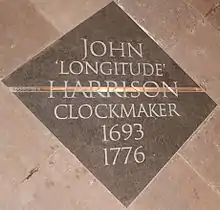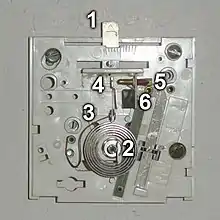Bimetallic strip
A bimetallic strip is used to convert a temperature change into mechanical displacement. The strip consists of two strips of different metals which expand at different rates as they are heated, usually steel and copper, or in some cases steel and brass. The different expansions force the flat strip to bend one way if heated, and in the opposite direction if cooled below its initial temperature. The metal with the higher coefficient of thermal expansion is on the outer side of the curve when the strip is heated and on the inner side when cooled.


The invention of the bimetallic strip is generally credited to John Harrison, an eighteenth-century clockmaker who made it for his third marine chronometer (H3) of 1759 to compensate for temperature-induced changes in the balance spring.[1] Harrison's invention is recognized in the memorial to him in Westminster Abbey, England.
This effect is used in a range of mechanical and electrical devices.
Characteristics
The strip consists of two strips of different metals which expand at different rates as they are heated, usually steel and copper, or in some cases steel and brass. The strips are joined together throughout their length by riveting, brazing or welding. The different expansions force the flat strip to bend one way if heated, and in the opposite direction if cooled below its initial temperature. The metal with the higher coefficient of thermal expansion is on the outer side of the curve when the strip is heated and on the inner side when cooled. The sideways displacement of the strip is much larger than the small lengthways expansion in either of the two metals.
In some applications, the bimetal strip is used in the flat form. In others, it is wrapped into a coil for compactness. The greater length of the coiled version gives improved sensitivity.
The curvature of a bimetallic beam can be described by the following equation:
where and is the radius of curvature, and are the Young's modulus and height (thickness) of material one and and are the Young's modulus and height (thickness) of material two. is the misfit strain, calculated by:
where α1 is the coefficient of thermal expansion of material one and α2 is the coefficient of thermal expansion of material two. ΔT is the current temperature minus the reference temperature (the temperature where the beam has no flexure).[2][3]
| Derivation of the radius of curvature | |
|---|---|
|
Let the layer on the concave side be layer 1 and on the convex side be layer 2, and let the thicknesses of each be and respectively. Layer 1 is in tension with a force outwards on each end of , while layer 2 is compressed with a force inwards on each end of . Because the system is in equilibrium . At each end of layer 1 there is a bending moment , and similarly for layer 2. If is the radius of curvature, then and where is the Flexural rigidity, is the Young's modulus and is the Second moment of area. For a rectangular cross-section of width , and . The couple produced by the forces acting along the mid-lines of each layer and separated by is , and again because the strip is in equilibrium and there are no external applied torques, . Hence
We now consider the contact surface between the two layers. The length of this surface for layer 1 is where is the temperature at which the strip is straight, is the length of the layer when the temperature (i.e. when it is straight and under no stress from layer 2), and is the coefficient of thermal expansion (the fractional increase in length per unit increase in temperature). The second term here is clearly the fractional change in length produced by the thermal expansion, the third term is the strain induced by the stress due to the force acting over the area of the end (positive because the force is tensile). The last term is the additional length of the contact surface relative to the mid-line of layer 1 (positive because the contact surface is the outer, convex surface). Similarly, the length of this surface for layer 2 is (minus signs because the force is compressive and the contact is on the inner surface). Since the surfaces are bonded,
Rearranging to extract , collecting terms and eliminating using the equation above produces the equation for in the main article. |
Insight may be gained if the result just given is multiplied on top and bottom by
where , and . Since for small , which is insensitive to because of the lack of first order terms, then we may approximate for close to unity (and insensitive to ), and for close to unity (and insensitive to ). Thus, unless or are very far from unity we can approximate .
History

The earliest surviving bimetallic strip was made by the eighteenth-century clockmaker John Harrison who is generally credited with its invention. He made it for his third marine chronometer (H3) of 1759 to compensate for temperature-induced changes in the balance spring.[4] It should not be confused with the bimetallic mechanism for correcting for thermal expansion in his gridiron pendulum. His earliest examples had two individual metal strips joined by rivets but he also invented the later technique of directly fusing molten brass onto a steel substrate. A strip of this type was fitted to his last timekeeper, H5. Harrison's invention is recognized in the memorial to him in Westminster Abbey, England.
Applications
This effect is used in a range of mechanical and electrical devices.
Clocks
Mechanical clock mechanisms are sensitive to temperature changes as each part has tiny tolerance and it leads to errors in time keeping. A bimetallic strip is used to compensate this phenomenon in the mechanism of some timepieces. The most common method is to use a bimetallic construction for the circular rim of the balance wheel. What it does is move a weight in a radial way looking at the circular plane down by the balance wheel, varying then, the momentum of inertia of the balance wheel. As the spring controlling the balance becomes weaker with the increasing temperature, the balance becomes smaller in diameter to decrease the momentum of inertia and keep the period of oscillation (and hence timekeeping) constant.
Nowadays this system is not used anymore since the appearance of low temperature coefficient alloys like nivarox, parachrom and many others depending on each brand.
Thermostats

In the regulation of heating and cooling, thermostats that operate over a wide range of temperatures are used. In these, one end of the bimetallic strip is mechanically fixed and attached to an electrical power source, while the other (moving) end carries an electrical contact. In adjustable thermostats another contact is positioned with a regulating knob or lever. The position so set controls the regulated temperature, called the set point.
Some thermostats use a mercury switch connected to both electrical leads. The angle of the entire mechanism is adjustable to control the set point of the thermostat.
Depending upon the application, a higher temperature may open a contact (as in a heater control) or it may close a contact (as in a refrigerator or air conditioner).
The electrical contacts may control the power directly (as in a household iron) or indirectly, switching electrical power through a relay or the supply of natural gas or fuel oil through an electrically operated valve. In some natural gas heaters the power may be provided with a thermocouple that is heated by a pilot light (a small, continuously burning, flame). In devices without pilot lights for ignition (as in most modern gas clothes dryers and some natural gas heaters and decorative fireplaces) the power for the contacts is provided by reduced household electrical power that operates a relay controlling an electronic ignitor, either a resistance heater or an electrically powered spark generating device.
Thermometers
A direct indicating dial thermometer, common in household devices (such as a patio thermometer or a meat thermometer), uses a bimetallic strip wrapped into a coil in its most common design. The coil changes the linear movement of the metal expansion into a circular movement thanks to the helicoidal shape it draws. One end of the coil is fixed to the housing of the device as a fix point and the other drives an indicating needle inside a circular indicator. A bimetallic strip is also used in a recording thermometer. Breguet's thermometer consists of a tri-metallic helix in order to have a more accurate result.
Heat engine
Heat engines are not the most efficient ones, and with the use of bimetallic strips the efficiency of the heat engines is even lower as there is no chamber to contain the heat. Moreover, the bimetallic strips cannot produce strength in its moves, the reason why is that in order to achieve reasonables bendings (movements) both metallic strips have to be thin to make the difference between the expansion noticeable. So the uses for metallic strips in heat engines are mostly in simple toys that have been built to demonstrate how the principle can be used to drive a heat engine.[citation needed]
Electrical devices
Bimetal strips are used in miniature circuit breakers to protect circuits from excess current. A coil of wire is used to heat a bimetal strip, which bends and operates a linkage that unlatches a spring-operated contact. This interrupts the circuit and can be reset when the bimetal strip has cooled down.
Bimetal strips are also used in time-delay relays, gas oven safety valves, thermal flashers for older turn signal lamps, and fluorescent lamp starters. In some devices, the current running directly through the bimetal strip is sufficient to heat it and operate contacts directly. It has also been used in mechanical PWM voltage regulators for automotive uses.[5]
See also
References
Notes
- Sobel, Dava (1995). Longitude. London: Fourth Estate. p. 103. ISBN 0-00-721446-4.
One of the inventions Harrison introduced in H-3... is called... a bi-metallic strip.
- Clyne, TW. "Residual stresses in surface coatings and their effects on interfacial debonding." Key Engineering Materials (Switzerland). Vol. 116–117, pp. 307–330. 1996
- Timoshenko, J. Opt. Soc. Am. 11, 233 (1925)
- Sobel, Dava (1995). Longitude. London: Fourth Estate. p. 103. ISBN 0-00-721446-4.
One of the inventions Harrison introduced in H-3... is called... a bi-metallic strip.
- https://www.minimania.com/Smiths_Voltage_Stabilizers